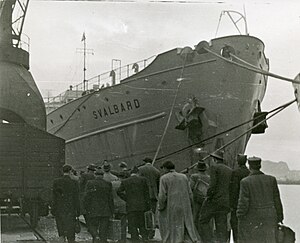German night fighter direction vessel Togo

Displaced Persons about to board HNoMS Svalbard (ex-Togo) in Genoa, Italy, in December 1948 for resettlement in Australia
|
|
| History | |
|---|---|
|
|
|
| Class and type: | Merchant vessel |
| Name: | Togo |
| Namesake: | Togo |
| Operator: | Woermann Line |
| Builder: | Bremer Vulkan, Vegesack |
| Launched: | 13 August 1938 |
| Homeport: | Hamburg |
| Identification: |
|
| Fate: | Requisitioned by Kriegsmarine, 1939 |
|
|
|
| Name: | Schiff 14 |
| Namesake: | Battle of Coronel |
| Operator: | Kriegsmarine |
| Builder: | Wilton, Rotterdam |
| Yard number: | 10 |
| Acquired: | Requisitioned, 1939 |
| Recommissioned: | December 1942 |
| Renamed: | (HSK Coronel, 1942) |
| Reclassified: |
|
| Homeport: | Kiel |
| Nickname(s): |
|
| Fate: | Transferred to the Luftwaffe, 1943 |
|
|
|
| Name: | Togo |
| Operator: | Luftwaffe |
| Acquired: | 1943 |
| Recommissioned: | 1943 |
| Reclassified: | Night fighter guide ship, 1943 |
| Homeport: | Kiel |
| Fate: | War booty, 1945; transferred from UK to USA, then to Norway |
| Badge: | |
|
|
|
| Class and type: | Troop and DP transport |
| Name: | Svalbard, then Tilthorn and Stella Marina |
| Acquired: | 14 March 1946 |
| Fate: | Sold |
|
|
|
| Class and type: | Cargo ship |
| Name: | Togo |
| Operator: | Deutsch Afrikanische Schiffahrts GmbH, Hamburg |
| Acquired: | November 1956 |
| Fate: | Sold |
|
|
|
| Class and type: | Merchant vessel |
| Name: | Lacasielle, then Topeka |
| Acquired: | March 1968 |
| Identification: | IMO number: 5363029 |
| Fate: |
|
| General characteristics As NJL Togo | |
| Type: | Night fighter guide ship |
| Displacement: | 12,700 t (12,500 long tons) |
| Length: | 134 m (439 ft 8 in) |
| Beam: | 17.9 m (58 ft 9 in) |
| Draft: | 7.9 m (25 ft 11 in) |
| Installed power: | 5,100 hp (3,800 kW) |
| Propulsion: |
|
| Speed: | 16 kn (30 km/h; 18 mph) |
| Endurance: | 36,000 nmi (67,000 km; 41,000 mi) at 10 kn (19 km/h; 12 mph) |
| Complement: | 283 crew plus 74 radar specialists from the Luftwaffe |
| Sensors and processing systems: |
|
| Armament: |
|
| Aircraft carried: | She could guide two night fighters simultaneously |
The MS Togo was a German merchant ship that was launched in 1938. Requisitioned by Nazi Germany's Kriegsmarine as Schiff 14, in April 1940 she participated in the invasion of Norway; in August 1940 was converted to a minelayer as part of the German plan to invade England; then from June 1941 she began conversion to the armed auxiliary cruiser (Hilfskreuzer) HSK Coronel.
Following Coronel's unsuccessful attempt in February 1943 to become the last German commerce raider of World War II, she was then used as a minesweeper (Sperrbrecher) before being recommissioned in late 1943 as NJL Togo, a night fighter direction vessel (Nachtjagdleitschiff), operating in the Baltic Sea.
As NJL Togo, she was the second of the Kriegsmarine's World War II radar ships, and the only one to survive the war.
After the war, Togo passed through various changes of ownership, name and function before finally being wrecked off the Mexican coast in 1984.
As built, Togo was 418.2 feet (127.47 m), long, with a beam of 58.7 feet (17.89 m) and a depth of 21.3 feet (6.49 m). Her gross register tonnage was 5,042, with a net register tonnage of 2,844. She was powered by two 8-cylinder Single Cycle Double Action diesel engines, each having cylinders of 28 3⁄4 inches (78 cm) diameter by 43 5⁄16 inches (110 cm) stroke. The engines gave a total of 1,556 NHP.
Togo was owned by Hamburg-Bremen-Afrika Linie A.G. and was operated by Woerman Linie A.G., operating as Deutsche Ost-Afrika Linie. The Code Letters DJXJ were allocated and her port of registry was Hamburg.
...
Wikipedia

